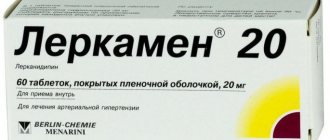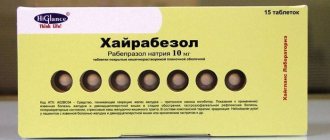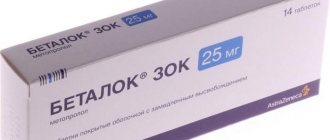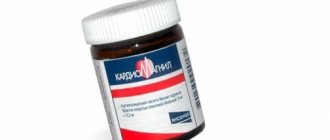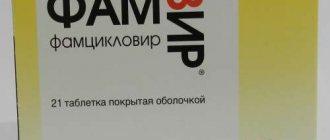Doctors at the Yusupov Hospital, after examining patients using modern diagnostic equipment and laboratory research methods, prescribe milgamma tablets for diseases caused by a deficiency of B vitamins. One milgamma tablet contains active substances - benfotiamine 100 mg, pyridoxine hydrochloride 100 mg, and auxiliary ingredients:
- Microcrystalline cellulose;
- Anhydrous colloidal silicon dioxide;
- Croscarmellose sodium;
- Povidone KZO, etc.
The shell of milgamma tablets contains shellac, sucrose, calcium carbonate and other substances. Due to the presence of sucrose, milgamma tablets are used with caution to treat patients suffering from diabetic neuropathy. Biconvex, film-coated tablets are white in color and have a smooth surface. It may have irregularities, roughness and small inclusions.
15 milgamma tablets are contained in a blister made of PVC/PVDC film and aluminum foil. The cardboard box contains 2 (30 milgamma tablets) or 4 (60 tablets) blisters along with instructions for use. The price of the drug is affordable, the reviews are good.
Compound
The composition of Milgamma in the form of a solution for intramuscular administration includes several active substances. In particular, the ampoules contain: pyridoxine hydrochloride , thiamine hydrochloride , cyanocobalamin , lidocaine hydrochloride .
Milgamma injections also contain additional substances: benzyl alcohol, potassium hexacyanoferrate, sodium hydroxide, sodium polyphosphate, water for injection.
Vitamins in tablets contain benfotiamine , pyridoxine hydrochloride , and also contain anhydrous colloidal silicon dioxide, croscarmellose sodium, microcrystalline cellulose, talc, povidone K30, and partial long-chain glycerides.
Release form
The medicine is available in the form of a solution (Milgamma injections for intramuscular administration), as well as in the form of tablets and dragees.
- Vitamins in the form of a solution are contained in 2 ml ampoules. The ampoules are made of brown hydrolytic glass, each of them has a label and a white dot. The package contains 5 or 10 ampoules.
- Film-coated tablets are packaged in 30 or 60 pcs.
- Milgamma Compositum pellets are also produced - biconvex, round in shape, white. The dragee is contained in a blister pack of 15 pieces. There may be 2 or 4 blisters in a cardboard pack.
pharmachologic effect
The drug Milgamma contains neurotropic vitamins, which belong to group B. The drug is used in a therapeutic dose for diseases of the nerves and nervous tissue, in which patients have impaired nerve conduction or inflammatory-degenerative phenomena.
The drug Milgamma is also prescribed to people with diseases of the musculoskeletal system. The use of a drug containing large doses of vitamin B relieves sharp pain, activates microcirculation processes, improves hematopoiesis and the functioning of the nervous system.
Vitamin B1 (thiamine), entering the body, is converted through phosphorylation into cocarboxylase and thiamine triphosphate. In turn, cocarboxylase takes part in the processes of carbohydrate metabolism, normalizing the functions of nervous tissue and nerves and improving conductivity in the nerves. If there is a deficiency of vitamin B1 in the body, then under-oxidized products of carbohydrate metabolism can accumulate in the tissues, provoking a variety of pathological conditions.
When determining which is better - Milgamma injections or tablets, it should be taken into account that instead of thiamine chloride, the tablets contain benfotiamine, a fat-soluble derivative of thiamine.
Vitamin B6 (pyridoxine) gets phosphorylated when it enters the body. The products of its metabolism are involved in the decarboxylation of amino acids, as a result of which physiologically active mediators are produced in the body - adrenaline , histamine, tyramine, dopamine, serotonin . In addition, vitamin B6 affects tryptophan metabolism.
Vitamins B1 and B6 provide potentiation of each other’s influence, therefore Milgamma vitamins in injections and tablets have a pronounced beneficial effect on the health of patients with diseases of the nerves and musculoskeletal system.
Vitamin B12 (cyanocobalamin) has an antianemic effect, activates the synthesis of nucleic acids, choline, creatinine, methionine. Takes part in metabolic processes in cells. The substance reduces pain resulting from damage to the peripheral nervous system and activates nucleic acid metabolism.
Lidocaine has a local anesthetic effect.
Vitamin B1 (thiamine)
Thiamine (B1) is responsible for normalizing carbohydrate metabolism in internal organs (liver, brain and living tissues). In addition, it is involved in the production of fatty acids and optimizes amino acid metabolism. An important function of thiamine is that it effectively reduces inflammation of the skin and improves the condition of the mucous membranes. Thiamine is involved in hematopoiesis and in the process of cell division, preventing the aging process of the body.
Thiamine is prescribed by specialists in the following cases:
- with liver disease;
- if the endocrine system is disrupted (consequences of obesity, diabetes);
- for eczema, psoriasis, pyoderma;
- in case of malfunction of the kidneys, brain and central nervous system;
- for gastritis, ulcers, pancreatitis and other gastrointestinal diseases.
Pharmacokinetics and pharmacodynamics
The abstract indicates that after intramuscular injection, thiamine is quickly absorbed and enters the blood. It is distributed unevenly in the body. Since there are no significant reserves of thiamine in the body, it must be supplied every day. The substance can penetrate the blood-brain and placental barriers. Excreted through the kidneys. Thiamine, compared to other vitamins, is stored in the body in the smallest quantities.
Pyridoxine , after the solution has been injected intramuscularly, quickly enters the bloodstream and is distributed throughout the body. Approximately 80% of the vitamin is bound to plasma proteins. The substance is able to penetrate the placenta and enters breast milk. Later it is oxidized to 4-pyridoxic acid, which is excreted through the kidneys after 2-5 hours.
Cyanocobalamin , entering the human blood, binds to proteins, resulting in the formation of a transport complex. Then, in this form, it is absorbed by the liver tissue. It also accumulates in the bone marrow. After cyanocobalamin is excreted into the intestines with bile, it can be reabsorbed.
Indications for use of Milgamma
The solution and tablets are prescribed as part of the complex treatment of diseases and syndromes of the nervous system that have different origins.
The following indications for the use of Milgamma are determined:
- neuritis;
- neuralgia;
- retrobulbar neuritis;
- facial nerve paresis
- ganglionitis (including herpes zoster );
- neuropathy;
- plexopathy;
- alcoholic, diabetic polyneuropathy .
There are also indications for the use of injections in people suffering from night cramps and neurological symptoms osteochondrosis . What the drug helps with as part of complex therapy, and why Milgamma injections are also prescribed, you can find out in more detail from your doctor.
Vitamin B12 (cyanocobalamin)
Cyanocobalamin (B12) helps accelerate the breakdown of proteins, fats and carbohydrates. Responsible for the synthesis of leukocytes, which are involved in protecting living tissues from foreign elements. Reduces cholesterol levels in the human body. Vitamin B12 helps normalize sleep and optimize the production of melatonin, the sufficient amount of which determines the sleep-wake cycle.
Indications for the use of cyanocobalamin are as follows:
- radiculitis;
- cirrhosis of the liver;
- polyneuritis;
- skin diseases (dermatitis, psoriasis);
- radiation sickness;
- bone injuries;
- acute and chronic hepatitis;
- bone injuries;
- radiculitis and others.
Side effects
Side effects of Milgamma appear, as a rule, in rare cases.
In particular, the following side effects are rarely possible:
- Immune system: allergic manifestations .
- Nervous system: impaired consciousness, dizziness .
- Cardiovascular system: tachycardia , arrhythmia , bradycardia.
- Digestive system: vomiting.
- Skin: severe sweating, itching , acne .
- Musculoskeletal and connective tissue: cramps .
Sometimes after Milgamma is administered intravenously to a patient, he may experience irritation in the area where the solution was injected. Systemic reactions can occur only with very rapid administration or in case of overdose.
If any other side effects occur or the negative effects described above are aggravated, you should immediately tell a specialist about this, who will give recommendations on how to inject the ampoules, or replace the drug.
Vitamin B6 (pyridoxine)
Pyridoxine (B6) is a water-soluble element that regulates metabolic processes and normalizes blood circulation. Pyridoxine is involved in the synthesis of molecules and the breakdown of carbohydrates. In addition, vitamin B6 reduces the risk of obesity, diabetes and the development of cardiovascular diseases. The level of cholesterol in the human body depends on the amount of vitamin B6. The role of vitamin B6 is indispensable in the synthesis of new red blood cells, i.e. this component is actively involved in the restoration of hematopoietic function. Like the other vitamins of the Milgamma complex, vitamin B6 affects the strengthening of the human immune system. In addition, a sufficient amount of pyridoxine protects against depression, relieves anxiety, and ensures calm.
Vitamin B6 is prescribed:
- patients with atherosclerosis, anemia and diabetes;
- pregnant women with toxicosis;
- teenagers with problems with improper functioning of the sebaceous glands.
Instructions for use of Milgamma (Method and dosage)
If a patient is prescribed Milgamma injections, the instructions for use must be carefully followed. Initially, the medicine is injected deep into the muscle, 2 ml once a day for 5-10 days. If the injections are intended for maintenance treatment, then 2 ml are administered 2-3 times a week. You can also take the drug in tablet form for maintenance therapy (1 tablet daily).
The instructions for use of Milgamma indicate that to quickly eliminate pain, you should use ampoules or tablets (1 tablet three times a day). Treatment can last about one month. The doctor should monitor the patient's health status weekly. Experts advise switching to internal administration of the drug as quickly as possible. Please note that Milgamma suppositories are not available.
The course of treatment with injections can last longer only as prescribed by a doctor. How often you can give injections, and what form of release is preferable in each specific case, you should also ask your doctor.
Contraindications and side effects
Taking Milgamma can cause side effects such as:
- Urticaria;
- Itching;
- Quincke's edema;
- Difficulty breathing and dyspnea;
- Hypersweating;
- Acne;
- Tachycardic signs;
- Anaphylactic shock;
- Bradycardia;
- Convulsive contractions of the calf muscles;
- Dizziness;
- Nausea.
Such adverse reactions, as a rule, develop in the case of too rapid intramuscular administration of Milgamma injections, as well as with excessively high dosages of the drug.
Among the contraindications to the use of the drug are the following:
- Age up to 16 years;
- Myocardial conduction disturbances;
- Hypersensitivity or individual intolerance to B vitamins;
- Presence of heart failure;
- Simultaneous use with alcohol.
Interaction
If vitamin B1 is mixed with sulfate solutions, it completely disintegrates.
Inactivation of thiamine (benfotiamine) is noted in the presence of acetates, mercury chloride, iodides, carbonates, riboflavin , tannic acid, ferric ammonium citrate, penicillin, metabisulfite.
Pyridoxine in therapeutic doses can reduce the effect of levodopa, therefore it is not used with levodopa and medications containing it. There is also interaction with Penicillamine , Cycloserine , Isoniazid .
Cyanocobalamin is inactivated in the presence of heavy metal salts. Riboflavin also has a destructive effect on it, especially with parallel exposure to light.
special instructions
There are special instructions that should be followed during use. Interactions with other drugs are possible: pyridoxine can reduce the effect of levodopa, simultaneous use of pyridoxine antagonists (for example, isoniazid, penicillamine, hydralazine, cycloserine), as well as alcohol consumption and long-term use of oral contraceptives with estrogen allows the possibility of vitamin B6 deficiency in the body and reduces effectiveness of Milgamma compositum.
When used together with fluorouracil, deactivation of thiamine is possible due to competitive suppression of thiamine phosphorylation by fluorouracil.
There are no warnings for the use of the drug by vehicle drivers and persons interacting with potentially dangerous mechanisms.
Milgamma's analogues
Level 4 ATX code matches:
Neurobex Forte
Neurobex
Milgamma Compositum
Neurorubin
Neurobion
Combilipen
If a replacement medication is needed, you may consider using similar medications that have similar effects on the body. What to replace the product with is determined only by the doctor, who will select the optimal analogues of Milgamma in injections and tablets. You can choose both imported and Russian analogues.
To date, the following drugs analogues of Milgamma are known: Neuromultivit , Binavit, Triovit , Pikovit , etc. The most optimal substitute is the analogue of Combilipen , as well as Neuromultivit.
The price of Milgamma's analogues is, as a rule, somewhat lower.
Which is better: Milgamma or Combilipen?
Combilipen is also a complex vitamin drug, which includes B vitamins. The drug is prescribed as part of complex therapy for patients with neurological diseases. These are similar products, only they have a different manufacturer, and Combilipen can be purchased at a lower price.
Neuromultivit or Milgamma - which is better?
The composition of these drugs is similar, but Neuromultivit does not include lidocaine among its components. Neuromultivit, unlike Milgamma, is prescribed for the treatment of children. Why each drug is prescribed will be explained in more detail by the treating specialist.
With alcohol
Milgamma is prescribed after alcohol intoxication in order to restore the body. At the same time, alcohol and Milgamma, both in injections and tablets, should not be consumed. Despite the fact that the compatibility of this medicine with alcohol is not described in the official instructions, such a combination completely neutralizes the positive effect of using the drug. Also, a number of side effects can be caused by combining alcohol and lidocaine: headache , drowsiness , anxiety .
Reviews about Milgamma
There are numerous reviews about Milgamma, which are left by both patients who have undergone such treatment and specialists. Reviews note that intramuscular injections are quite painful, and sometimes there is irritation at the site where the injection was administered. But more often a positive effect is described in the treatment of neuralgia, neuritis and other diseases that were noted after the patient was given injections of Milgamma. Reviews from doctors contain information that during treatment, patients must lead a correct lifestyle and follow all recommendations, since the remedy only eliminates the symptoms, but not the cause of the disease.
The effectiveness of the drug in complex therapy is also often noted, for which not only this drug is prescribed, but also other drugs. For example, a good effect can be obtained if Movalis and Milgamma are prescribed simultaneously. Movalis is a non-steroidal anti-inflammatory drug that has a pronounced positive effect on diseases of the musculoskeletal system.
Overdose
An overdose of vitamin B6 may cause neurotoxic effects. When treated with large doses of this vitamin for more than six months, neuropathy may develop. polyneuropathy may occur , which is accompanied by ataxia. Taking large doses of medication may cause convulsions. An overdose of benfotiamine when taken orally is unlikely.
After taking high doses of pyridoxine, induce vomiting and then take activated charcoal . However, such measures are effective only in the first 30 minutes. In more serious cases, you should immediately contact a specialist.
Milgamma price, where to buy
The price of Milgamma injections No. 5 is on average 330 rubles. The price of Milgamma in ampoules injections No. 10 is from 500 to 600 rubles. The price of Milgamma injections (pack of 25 pieces) averages 1,100 rubles. You can buy Milgamma in Moscow (tablets, 30 pcs.) for an average of 650 rubles.
The cost of ampoules in Ukraine is from 140 to 200 hryvnia per pack of 5 pcs. How much the medicine costs in different packages should be found out at the specific point of sale. The drug in tablets (30 pieces) can be bought on average for 200-250 hryvnia.
- Online pharmacies in RussiaRussia
- Online pharmacies in UkraineUkraine
- Online pharmacies in KazakhstanKazakhstan
ZdravCity
- Milgamma solution for intramuscular injection.
2ml 5 pcs. Vervag Pharma/Solupharm GmbH RUB 371 order - Milgamma solution for intramuscular injection. 2ml 25 pcs. Vervag Pharma/Solyufarm GmbH
RUB 1,451 order
- Milgamma solution for intramuscular injection. 2ml 10 pcs. Solyufarm GmbH
RUB 632 order
Pharmacy Dialogue
- Milgamma ampoules 2ml No. 10Worwag pharma
608 rub. order
- Milgamma ampoules 2ml No. 25Worwag pharma
1350 rub. order
- Milgamma ampoules 2ml No. 5Worwag pharma
380 rub. order
show more
Pharmacy24
- Milgamma 100 mg No. 30 tablets Mauermann-Artsnaimitel KG, Nimechchina
369 UAH.order - Milgamma 100 mg No. 60 tablets Mauermann-Artsnaimitel KG, Nimechchina
670 UAH. order
- Milgamma 2 ml No. 10 solution Solyufarm Pharmaceuticals Erzoignisse GmbH, Nimecchina
296 UAH. order
- Milgamma 2 ml No. 5 solution for injection Solyufarm Pharmaceuticals Herzoignisse GmbH, Nimecchina
146 UAH order
PaniPharmacy
- Milgamma ampoule Milgamma injection solution ampoules 2ml No. 5 Germany, Woerwag Pharma
191 UAH order
- Milgamma ampoule Milgama solution for injection. amp. 2 ml No. 10 Germany, Solupharm
289 UAH order
- Milgamma tablets Milgamma film-coated tablets No. 30 Germany, Mauermann-Arzneimittel
426 UAH order
- Milgamma tablets Milgamma film-coated tablets No. 60 Germany, Mauermann-Arzneimittel
767 UAH. order
show more
Prices for services
| Name of service | Price |
| Consultation with a rehabilitation specialist (initial) | Price 5,150 rub. |
| Consultation with a rehabilitation specialist (secondary) | Price 3,600 rub. |
| Comprehensive rehabilitation program after stroke | Price from 14,839 rub. per day |
| Comprehensive rehabilitation program after spinal injury | Price from 15,939 rub. per day |
| Comprehensive rehabilitation program for Alzheimer's disease | Price from 15,389 rub. per day |
| Comprehensive rehabilitation program for Parkinson's disease | Price from 13,739 rub. per day |
| Comprehensive rehabilitation program for multiple sclerosis | Price from 14,839 rub. per day |
| Massotherapy | Price from 2,200 rub. |
| Session with a speech therapist | Price from 3,410 rub. |
| Individual lesson on psychological social adaptation | Price 4,565 rub. |
| Acupuncture session | Price 4,290 rub. |
